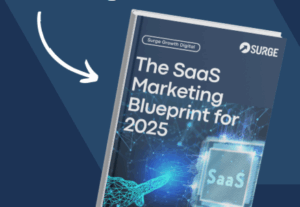For SaaS businesses, churn rate is a critical metric that directly impacts revenue and growth. High churn rates indicate customer dissatisfaction, poor retention strategies, or inefficiencies in the SaaS customer lifecycle. Understanding churn rates in SaaS and implementing effective customer retention strategies is key to sustainable success.
Need help optimising your SaaS retention strategy? Contact Surge Growth Digital – The SaaS Marketing Agency Focused on Scaling Your Business.
What is Churn and Why is it Important in SaaS?
Defining Churn and Churn Rate
Churn rate measures the percentage of customers who stop using a SaaS product over a specific period. It is a key SaaS metric used to assess customer retention and overall business health.
Why Churn Matters for SaaS Businesses
- Revenue Loss – Losing customers means losing recurring revenue.
- Customer Acquisition Cost (CAC) Impact – High churn increases CAC since replacing lost customers is costly.
- Business Growth – A low churn rate enables long-term scalability.
The Impact of High Churn Rates on Revenue
A high churn rate can stall revenue growth, making it harder to achieve profitability. SaaS companies must balance customer acquisition with strong retention strategies to prevent revenue loss.
How to Calculate Your Churn Rate?
Understanding the Churn Rate Formula
Churn Rate = (Number of Customers Lost ÷ Total Customers at the Start of the Period) × 100
Steps to Calculate Customer Churn Rate
- Determine the number of customers at the beginning of the period.
- Track the number of customers lost during that time.
- Apply the formula to measure churn percentage.
Utilising a Churn Rate Calculator
Online tools like HubSpot’s Churn Calculator can help SaaS businesses quickly assess and analyse churn trends.
What is Considered a Good Churn Rate?
Average Churn Rate Benchmarks by Industry
| Industry | Average Monthly Churn Rate |
| B2B SaaS | 3-5% |
| B2C SaaS | 5-7% |
| Enterprise SaaS | 1-2% |
Identifying a Good Churn Rate for Your SaaS
For SaaS businesses, a monthly churn rate below 5% is considered healthy, while enterprise SaaS aims for below 2%.
Comparing Churn Rate vs Customer Retention Rate
- Churn Rate = Percentage of customers lost.
- Retention Rate = Percentage of customers retained.
Lower churn leads to higher retention and better revenue stability.
What Are the Common Causes of Customer Churn?
Understanding Voluntary vs Involuntary Churn
- Voluntary Churn – Customers leave due to dissatisfaction, pricing, or competitors.
- Involuntary Churn – Payment failures, expired credit cards, or system errors.
The Role of Customer Experience in Churn
- Poor onboarding leads to low engagement.
- Weak customer support increases frustration.
- Lack of product updates or innovation causes disengagement.
Identifying Patterns in Customer Churn Analysis
- Analyse customer feedback for common pain points.
- Track NPS (Net Promoter Score) to gauge satisfaction.
- Monitor product usage data for signs of disengagement.
How to Reduce Customer Churn in Your SaaS Business?
Strategies to Improve Customer Retention
- Enhance onboarding experiences to increase product adoption.
- Offer proactive customer support to prevent frustration.
- Use personalised engagement strategies for long-term loyalty.
Leveraging Customer Feedback to Reduce Churn
- Conduct surveys and interviews to understand user pain points.
- Implement feature requests based on customer needs.
- Address negative reviews and resolve support tickets promptly.
Implementing Effective Onboarding Processes
- d support tickets promptly.Provide step-by-step tutorials and in-app guides.
- Assign dedicated customer success managers.
- Offer personalised onboarding sessions for enterprise clients.
How Does Churn Rate Vary Across Different Industries?
Churn Rate by Industry: Key Insights
SaaS churn rates differ based on pricing models, customer types, and contract lengths. B2C SaaS experiences higher churn due to short-term subscriptions, while B2B SaaS benefits from longer contracts, which can help reduce churn. Understanding these factors is crucial for SaaS businesses aiming to minimise churn and improve customer retention.
Industry-Specific Strategies to Reduce Churn
| Industry | Churn Reduction Strategies |
| B2B SaaS | Focus on long-term contracts & ABM |
| B2C SaaS | Gamification & loyalty rewards |
| Enterprise SaaS | High-touch customer success teams |
Analysing Churn Rates in SaaS vs Other Sectors
Compared to eCommerce or retail, SaaS businesses experience lower churn if they provide high-value, sticky products.
What Metrics Should You Monitor Alongside Churn Rate?
Understanding Customer Lifetime Value (CLV)
- Customer Lifetime Value (CLV) represents the total revenue a business can expect from a customer over their entire engagement period.
- Increasing customer retention directly improves CLV.
Tracking Customer Satisfaction and Loyalty
- Net Promoter Score (NPS) – Measures brand loyalty.
- Customer Satisfaction Score (CSAT) – Assesses product/service satisfaction.
- Retention Rate – Tracks long-term engagement.
Using SaaS Metrics to Analyse Churn and Retention
| Metric | Importance |
| Churn Rate | Customer loss monitoring |
| CLV | Long-term revenue forecasting |
| CAC | Cost of acquiring new customers |
| Expansion Revenue | Upsell & cross-sell effectiveness |
Conclusion
Managing churn rates in SaaS is essential for long-term success. By focusing on customer retention, improving user experiences, and leveraging insights from SaaS metrics, businesses can reduce churn and increase revenue stability.
Struggling with high churn? Contact Surge Growth Digital today for expert SaaS retention strategies!
FAQs
- What is a normal churn rate for SaaS?
A 3-5% monthly churn rate is typical for B2B SaaS, while enterprise SaaS aims for 1-2% churn. - How do you reduce churn in SaaS?
Improve onboarding, offer proactive support, and engage customers through personalised interactions. - Why is churn rate a key metric in SaaS?
Churn rate impacts recurring revenue, CAC efficiency, and long-term growth potential. - How does SaaS pricing affect churn rate?
High pricing or complex contracts can increase churn. Freemium and flexible pricing help improve retention. - What role does customer success play in reducing churn?
Customer success teams help clients maximise value, reducing churn and increasing satisfaction.






